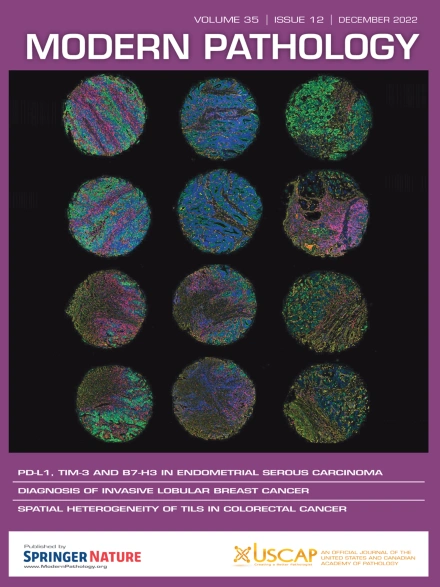乳腺癌前哨淋巴结和靶向淋巴结冷冻切片全切片的前瞻性和回顾性分析。
IF 7.1
1区 医学
Q1 PATHOLOGY
引用次数: 0
摘要
目前在外科病理实践中,冷冻切片(FS)评估有不同类型的数字模式。然而,有有限的研究表明,全玻片成像(WSI)作为FS诊断的一个强大的数字病理学选择的潜力。在目前的研究中,我们比较了WSI与光镜(LM)在评估乳腺癌患者腋窝前哨淋巴结(SLNs)和夹持淋巴结(LNs)的FSs时的诊断准确性。最初,在2至6周的洗脱期后,使用WSI和LM对109个sln的苏木精和伊红(H&E)染色的FSs进行回顾性分析。随后,由第一位病理学家使用LM对132个sln的FSs进行前瞻性分析,然后由另一位病理学家对h&e染色的FSs进行远程实时扫描和解释。在回顾性分析中,使用WSI的诊断准确性范围为96%至99%,与LM的诊断准确性范围为94%至99%相似。同样,前瞻性分析也显示WSI(96.2%)和LM(97%)的诊断准确性相当。与LM相比,病理学家在回顾性研究中需要额外的0.8-5.4分钟来使用WSI进行诊断(p0.05)。总之,我们的研究表明,基于wsi的评估在评估LN FSs方面具有与LM相当的诊断准确性。此外,该前瞻性研究证明了实时获取高质量wsi用于sln远程FS诊断的可行性。这些发现证实了使用sln和夹取ln的wsi作为外科病理实践中护理标准对乳腺癌患者进行实时FS评估的潜力。本文章由计算机程序翻译,如有差异,请以英文原文为准。
Prospective and Retrospective Analysis of Whole-Slide Images of Sentinel and Targeted Lymph Node Frozen Sections in Breast Cancer
Different digital modalities are currently available for frozen section (FS) evaluation in surgical pathology practice. However, there are limited studies that demonstrate the potential of whole-slide imaging (WSI) as a robust digital pathology option for FS diagnosis. In the current study, we compared the diagnostic accuracy achieved with WSI to that achieved with light microscopy (LM) for evaluating FSs of axillary sentinel lymph nodes (SLNs) and clipped lymph nodes (LNs) from patients with breast cancer using 2 modalities. Initially, a retrospective analysis evaluated hematoxylin and eosin (H&E)-stained FSs of 109 SLNs using WSI followed by LM after a washout period ranging from 2 to 6 weeks. Subsequently, a prospective analysis assessed FSs of 132 SLNs using LM by the first pathologist, and then H&E-stained FSs were scanned and interpreted remotely in real time by a different pathologist. In the retrospective analysis, the diagnostic accuracy utilizing WSI ranged from 96% to 99% and exhibited similarity to those achieved with LM, ranging from 94% to 99%. Similarly, the prospective analysis also demonstrated comparable diagnostic accuracy between WSI (96.2%) and LM (97%). Pathologists in the retrospective study required an additional 0.8 to 5.4 minutes to render diagnoses using WSI compared with LM (P < .0001). In the prospective study conducted 2 years later, pathologists only took slightly longer to provide WSI FS diagnoses (3.95 minutes) compared with LM (3.51 minutes) (P > .05). In conclusion, our study indicated that WSI-based evaluation showed comparable diagnostic accuracy to LM for assessing LN FSs. Furthermore, the prospective study demonstrated the feasibility of real-time acquisition of high-quality WSIs for remote FS diagnosis of SLNs. These findings substantiate the promising potential of using WSIs of SLNs and clipped LNs in real-time FS evaluation of patients with breast cancer as a standard-of-care in surgical pathology practice.
求助全文
通过发布文献求助,成功后即可免费获取论文全文。
去求助
来源期刊

Modern Pathology
医学-病理学
CiteScore
14.30
自引率
2.70%
发文量
174
审稿时长
18 days
期刊介绍:
Modern Pathology, an international journal under the ownership of The United States & Canadian Academy of Pathology (USCAP), serves as an authoritative platform for publishing top-tier clinical and translational research studies in pathology.
Original manuscripts are the primary focus of Modern Pathology, complemented by impactful editorials, reviews, and practice guidelines covering all facets of precision diagnostics in human pathology. The journal's scope includes advancements in molecular diagnostics and genomic classifications of diseases, breakthroughs in immune-oncology, computational science, applied bioinformatics, and digital pathology.
 求助内容:
求助内容: 应助结果提醒方式:
应助结果提醒方式:


